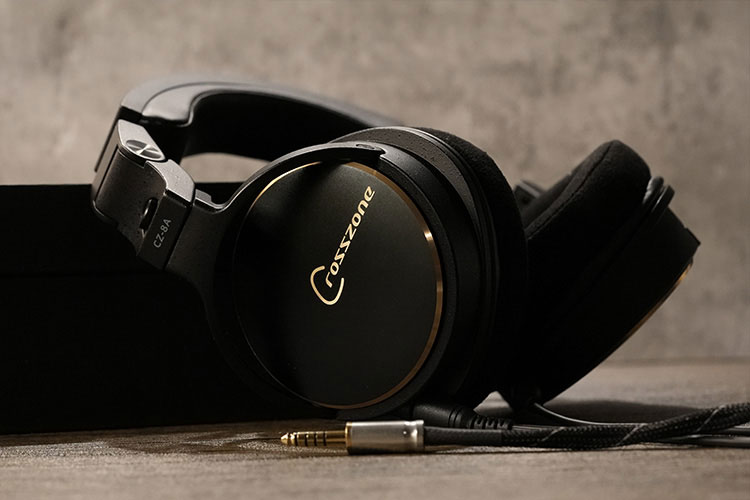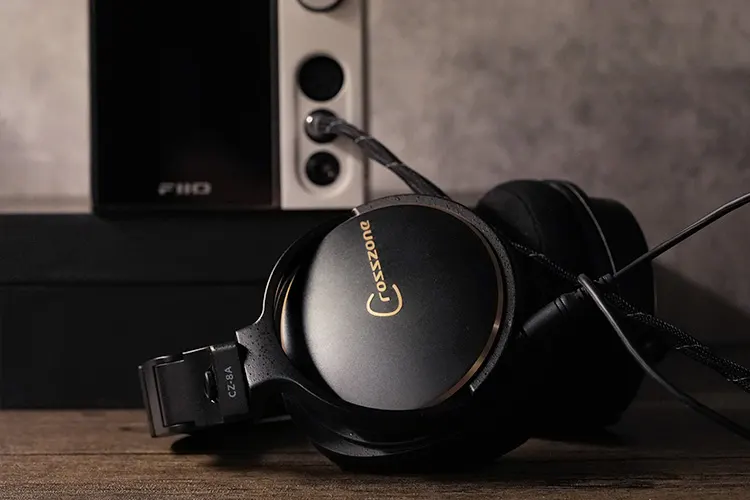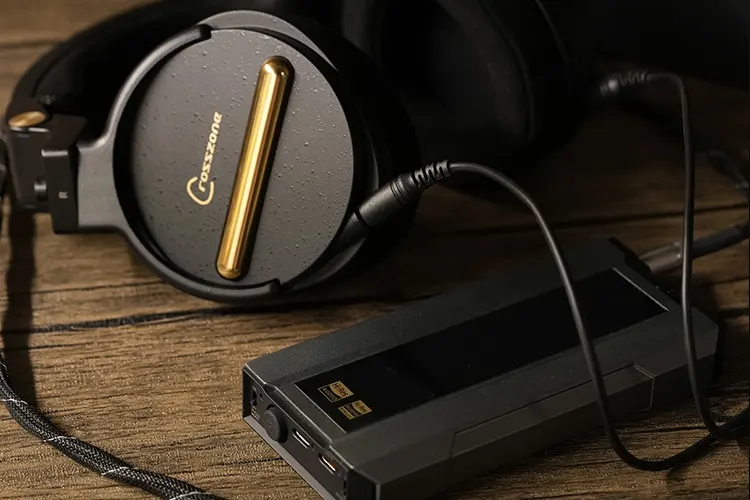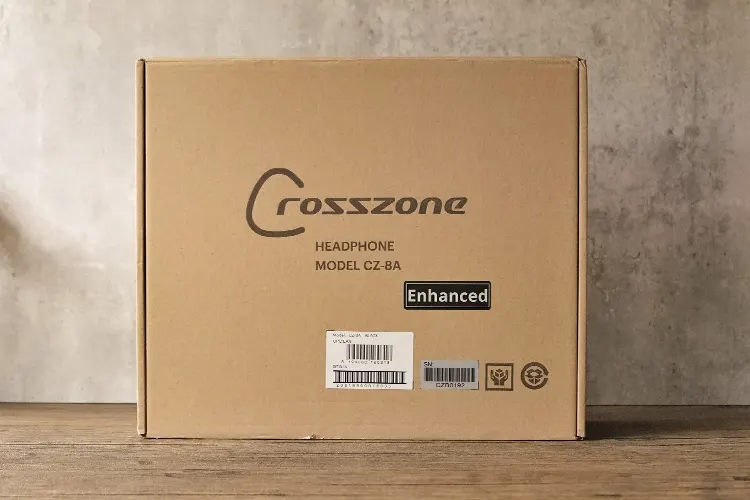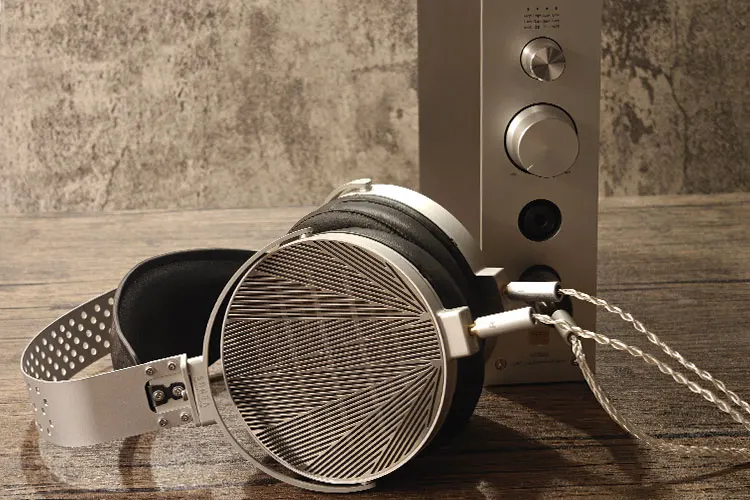Synergy
Efficiency
The CZ-8A Enhanced has a relatively high impedance rating at 75Ω and an SPL of 100 dB/mW so it can be assumed that powerful amplification will be needed.
The design also uses rigid Beryllium-plated driver membranes which in my experience will require more power to sound dynamic and airy.
Testing with portable players for example the Shanling M5 Ultra, offers adequate clarity as the two ends are elevated. However, the staging feels confined especially on the x-axis and the mid-bass feels a bit fat and shouty.
Powerful desktop gears refine the output and enhance the definition which helps this pair of headphones deliver a bigger stereo image.
Using the stock cable, the tonal balance with lighter, softer voices is better. Hoarse, darker voices may lack power and sound overshadowed by the bass.
Again, it is recommended to use the 4.4mm upgrade cable that can enhance the overall balance and clarity, giving the vocal more bite and penetration power and enhancing the treble’s brilliance.
Pairings
The CZ-8A Enhanced has good responsiveness to cable rolling. The balanced 4.4 cable from Crosszone, featuring Litz OFC cores, notably enhances the bass presence and dynamics while presenting cleaner mids.
This enables a fuller and more balanced sound profile, particularly beneficial when paired with less powerful equipment. However, its full potential shines when connected to a robust amplifier and high-quality decoding.
With the FiiO R9, the CZ-8A Enhanced delivers controlled and swift articulation, though even at higher gain you can feel there is room for the mids to sound more defined and the treble to open up more.
Stepping up to the more potent FiiO K19 results in even more solid lows, creating a deeply immersive atmosphere where vocals are more effortlessly extended.
When tested with the HIFIMAN EF500, the output leans towards a denser, more mid-centric sound profile, particularly soothing for instrumental and acoustic music. The warmth in this pairing is notable, revealing subtle details in the bass, such as the nuanced hammering weight in piano tracks
With high-quality decoders like the RME ADI-2 Pro, it will sound more balanced and well-articulated in the mids and help to bring forth clearer and more precise mids. Without proper amplification, the CZ-8A may sound compressed and overly thick in the mid-low region.
Select Comparisons
Crosszone CZ-10 Enhanced
Technical
The CZ-10 Enhanced and CZ-8A Enhanced both use a triple dynamic driver configuration within a closed cup design.
However, the structure is quite different as the CZ-8A moves the proprietary Acoustic Delay Chamber within an Aluminum cover, which enhances shielding quality and reduces EMF on the driver as explained by Crosszone.
The CZ-8A Enhanced also employs a 40mm bass driver instead of the 35mm bass drivers on the CZ-10 Enhanced, with enlarged vents for the bass drivers which gives the bass more power and air.
When looking at the inner side of the headphones, you will also find much more detail around the vents, which are waveguide structures to alter the waveforms.
Some other physical designs are common for the two, for example, the duct for opposite channel sound reproduction and the ways the drivers are placed.
Design
Both headphones are very well built even though they are using a plastic frame. The finishing is beautiful even though the design may look a bit plain. If I had to pick one, I would choose the CZ-8A Enhanced which is very finely engineered while being stealthier in design.
The metallic, elevated logo on the ear-cups of the CZ-8A Enhanced requires more engineering effort but helps the design look more premium. The round ear-cup design with the fulcrum-shaped earpads hidden below also makes the design look cooler while retaining good levels of comfort.
Additionally, the CZ-10 Enhanced is 50g heavier though in practice the difference feels marginal as the design very effectively shares the weight on the head.
Performance
Comparing the two headphones on the FiiO Q15, it is evident that the tuning on the CZ-8A Enhanced sounds clearer and more powerful in the bass.
The CZ-10 Enhanced is more mid-centric, while the CZ-8A feels more balanced, enhancing the perceived resolution and clarity by emphasizing the upper vocal frequencies and lower bass.
This adjustment is beneficial as the stronger bass energy further strengthens the holographic presentation.
Coupled with the elevated treble and increased openness, it creates an experience akin to listening in a larger space with heart-pounding bass, contrasting with the more confined presentation of the CZ-10 Enhanced.
I find the CZ-8A Enhanced to sound more natural and organic, likely due to its stronger outlining effect on vocals and bass instruments.
The fundamental bass frequencies carry more intensity. This provides better depth and presence to backing instruments without sounding as thick in the mid-lows, which could reduce clarity as heard on the CZ-10 Enhanced.
The slightly heightened upper vocal frequencies enable vocals to cut through more effortlessly on the CZ-8A Enhanced, with sibilant tones more emphasized, resembling a more life-like live sound experience and allowing vocals to be positioned more clearly.
Sennheiser HD800s
Technical
The HD800s is one of the faster more articulate and defined-sounding headphones for midrange frequencies.
However, it has a rather high 300Ω impedance rating and 102 dB@1mW sensitivity, making it pickier for amps than the 75Ω impedance and 100 dB@1mW sensitivity rated CZ-8A Enhanced.
The Crosszone may seem easier to drive but remember there are 3 drivers so it will still need good power to sound optimal
Design
Compared to the HD800s, the CZ-8A Enhanced looks much stealthier with more subtle venting on the side of the ear-cups.
Isolation is better on the closed-back CZ-8A Enhanced but both headphones are equally comfortable with the Crosszone sealing slightly better with its spring-loaded structure.
While both headphones use plastic as the primary material to build the housing I would argue that the HD800s is much bolder with the frame with that aluminum cover on top.
Overall, the CZ-8A Enhanced feels even more sturdy than the HD800s with a scratch-proof finish, unlike the HD800 series which always has the paint scratched off.
Performance
Comparing the two on the FiiO K19, the HD800s feel more precisely imaged, rendering a wider lateral stage. The CZ-8A Enhanced sounds deeper and quite a bit richer in the mids, even when listening to a song mixed to sound clean on the HD800s.
The elevation in the upper mids on the CZ-8A Enhanced also gives the vocals more sharpness and slightly more sibilance compared to the HD800s, which is tamer in the upper mids.
The CZ-10 Enhanced adds much more warmth and fullness in the mids, stretching the image to be more holographic and denser, placing the vocalist clearly in the front while giving the lower end sufficient energy to fill the rendered space.
This empowers bass instruments to have a much stronger presence and weight, bringing out nuances such as chamber resonances and string plucking, which sustain well and are more detectable than on the HD800s which doesn’t amplify these details.
Strings and acoustic instruments, in particular, sound very engaging on the CZ-8A Enhanced. Whereas the HD800s delivers a cleaner outline and is presented in a more precise and accurate manner.
With fast percussions, the HD800s has a clear advantage in resolving power and responsiveness in the bass. The CZ-8A Enhanced may sound more messy as the bass builds up.
The CZ-8A Enhanced pans different elements to the front, making you feel like you are listening as an audience instead of sitting in the position of the drummer.
It doesn’t feel like listening to the same track when switching between the two headphones, and unexpectedly, I don’t find the CZ-8A Enhanced sounding unnatural in many cases when it alters the presentation this much.
MOONDROP Venus
Technical
The Venus has a 100mm large, sub-nanometer diaphragm. It is rated at 18Ω and 100 dB/Vrms, requiring more power to sound as loud as the CZ-8A Enhanced on paper.
In practice, the CZ-8A Enhanced feels less demanding, though both headphones will require quite a strong amplifier and decoder to sound textured and opened up.
The CZ-8A Enhanced feels more picky for sources in this case as its treble peak is more prominent which will require a powerful yet controlled setup.
Design
The Venus has beautiful metallic grills on top and a full metallic structure, while the CZ-8A looks much bolder with its more complicated structure. The style is very different but clearly, the finishing and maturity in design are nicer on the CZ-8A Enhanced.
For isolation and comfort, the CZ-8A is also better as it is vented on the sides. The thick headband shares the weight more evenly while the fulcrum-shaped cups are more easily fitted on the ears without any adjustments.
Performance
The Venus impressed me with its bass agility and power, and since the CZ-8A Enhanced sounds very deep and powerful in the subs, I am tempted to compare it against the Venus.
When playing the same track, the Venus delivers the bass more cleanly with transients finely captured. The CZ-8A Enhanced provides the bass line with stronger texture and fullness.
It seems to add extra dimensions to the output, such as reverberating qualities and added harmonics due to the stacked channels. The bass quantity and depth are comparable, with the Venus feeling fuller in the mid-lows, favoring darker voices.
While the Venus positions the vocals more upfront and articulates them swiftly, it does not texture and weigh the fundamental vocal frequencies as much. Nor does it emphasize the air and harmonics as much as the CZ-8A Enhanced.
The CZ-8A Enhanced presents most tracks in a more 3D way, smoothing out the lower frequencies while maintaining similar penetration power in the upper register.
Overall, the coloring is much stronger on the CZ-8A Enhanced than on the Venus, which paints the output livelier and more cohesive, though sometimes not as defined.
My Verdict
Crosszone has further refined the openness and balance of the CZ-8A Enhanced, showcasing that headphones can push boundaries by leveraging multiple drivers and unique technologies to achieve what they term external sound localization.
It offers a redefined listening experience that adds a holographic quality to whatever is being played, reinterpreting tracks in an unheard way without sounding unnatural, especially after making some minor EQ adjustments.
It’s worth noting that the CZ-8A Enhanced demands robust amplification due to its power requirements, and It works better with tracks that have strong dynamics and better mastering, and with less defined, lossy tracks it may sound bloated.
If you are looking for a strong holographic presentation, with dense and rich harmonics, it is worth demoing the unique soundscape rendered on the Crosszone CZ-8A Enhanced.
Crosszone CZ-8A Enhanced Technical Specifications
- Type, Closed type
- Frequency Range, 20Hz-40kHz
- Sensitivity, 100dB
- Impedance, 75Ω
- Weight, 435g(Body only)
- Accessories, Specific cables 1.5m(Φ3.5mm mini plug ), 3.5m(Φ6.3mm standard plug )

